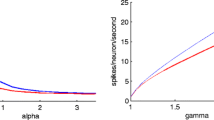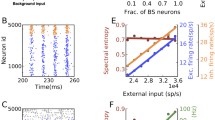Abstract
Synchrony-driven recruitment learning addresses the question of how arbitrary concepts, represented by synchronously active ensembles, may be acquired within a randomly connected static graph of neuron-like elements. Recruitment learning in hierarchies is an inherently unstable process. This paper presents conditions on parameters for a feedforward network to ensure stable recruitment hierarchies. The parameter analysis is conducted by using a stochastic population approach to model a spiking neural network. The resulting network converges to activate a desired number of units at each stage of the hierarchy. The original recruitment method is modified first by increasing feedforward connection density for ensuring sufficient activation, then by incorporating temporally distributed feedforward delays for separating inputs temporally, and finally by limiting excess activation via lateral inhibition. The task of activating a desired number of units from a population is performed similarly to a temporal k-winners-take-all network.
Similar content being viewed by others
References
Amari S (1974) A method of statistical neurodynamics. Kybernetik 14:201–215
Arik S (2002) A note on the global stability of dynamical neural networks. IEEE Trans Circ Syst I: Fundam Theory Appl 49(4):502–504
Calvert BD, Marinov CA (2000) Another k-winners-take-all analog neural network. IEEE Trans Neural Netw 11(4):829–838
Diesmann M, Gewaltig M-O, Aertsen A (1999) Stable propagation of synchronous spiking in cortical neural networks. Nature 402:529–533
Elias SA, Grossberg S (1975) Pattern formation, contrast control, and oscillations in the short term memory of shunting on-center off-surround networks. Biol Cybern 20:69–98
Feldman JA (1982) Dynamic connections in neural networks. Biol Cybern 46:27–39
Feldman JA (1990) Computational constraints on higher neural representations. In: Schwartz EL (eds). Computational neuroscience, system development foundation benchmark series, chap 13. MIT Press, Cambridge, pp. 163–178
Feldman JA, Ballard DH (1982) Connectionist models and their properties. Cogn Sci 6:205–254
Gerbessiotis AV (1993) Topics in parallel and distributed computation. PhD thesis, The Division of Applied Sciences, Harvard University, Cambridge, Massachusetts
Gerbessiotis AV (1998) A graph-theoretic result for a model of neural computation. Discrete Appl Math 82:257–262
Gerbessiotis AV (2003) Random graphs in a neural computation model. Int J Comput Math 80:689–707
Gerstner W (1999) Spiking neurons. In: Maass W, Bishop CM (eds). Pulsed neural networks, chap 1. MIT Press, Cambridge, pp. 3–54
Günay C (2003) Hierarchical learning of conjunctive concepts in spiking neural networks. PhD thesis, Center for Advanced Computer Studies,University of Louisiana at Lafayette, Lafayette,LA 70504-4330,USA
Günay C, Maida AS (2001) The required measures of phase segregation in distributed cortical processing. In: Proceedings of the international joint conference on neural networks, Washington, DC, vol 1, pp. 290–295
Günay C, Maida AS (2003) Temporal binding as an inducer for connectionist recruitment learning over delayed lines. Neural Netw 16(5–6):593–600
Günay C, Maida AS (2005) Using temporal binding for hierarchical recruitment of conjunctive concepts over delayed lines. Neurocomputing (in print)
Hinton GE, McClelland JL, Rumelhart DE (1986) Distributed representations. In: Rumelhart DE, McClelland JL, the PDP Research Group (eds) Parallel distributed processing: explorations in the microstructure of cognition, Foundations, vol 1. MIT Press, Cambridge, pp 77–109
Hopfield JJ (1982) Neural networks and physical systems with emergent collective computational properties. Proc Natl Acad Sci 79:2554–2558
Indiveri G (2000) Modeling selective attention using a neuromorphic analog VLSI device. Neural Comput 12(12):2857–2880
Kaszkurewicz E, Bhaya A (1994) On a class of globally stable neural circuits. IEEE Trans Circuits Syst I: Fundam Theory Appl 41(2):171–174
Knoblauch A, Palm G (2001) Pattern separation and synchronization in spiking associative memories and visual areas. Neural Netw 14:763–780
Koch C, Poggio T, Torre V (1983) Nonlinear interactions in a dendritic tree: localization timing and role in information processing. Proc Natl Acad Sci 80:2799–2802
Levy WB (1996) A sequence predicting CA3 is a flexible associator that learns and uses context to solve Hippocampal-like tasks. Hippocampus 6:576–590
Litvak V, Sompolinsky H, Segev I, Abeles M (2003) On the transmission of rate codes in long feedforward networks with excitatory-inhibitory balance. J Neurosci 23(7):3006–3015
Maass W (2000) On the computational power of winner-take-all. Neural Comput 12(11):2519–2536
Minai AA, Levy WB (1993) The dynamics of sparse random networks. Biol Cybern 70:177–187
Minai AA, Levy WB (1994) Setting the activity level in sparse random networks. Neural Comput 6:85–99
O’Reilly RC, Busby RS, Soto R (2003) Three forms of binding and their neural substrates: alternatives to temporal synchrony. In: Cleeremans A (eds). The unity of consciousness: binding, integration and dissociation. Oxford University Press, Oxford
Page M (2000) Connectionist modelling in psychology: a localist manifesto. Behav Brain Sci 23(4):443–467
Phillips CL, Harbor RD (1991) Feedback control systems, 2nd edn. Prentice Hall, New Jersey
Shadlen MN, Newsome WT (1994) Noise, neural codes and cortical organization. Curr Opin Neurobiol 4:569–579
Shadlen MN, Newsome WT (1998) The variable discharge of cortical neurons: implications for connectivity, computation, and information coding. J Neurosci 18(10):3870–3896
Shastri L (1999) Recruitment of binding and binding-error detector circuits via long-term potentiation. Neurocomputing 26–7:865–874
Shastri L (2001) Biological grounding of recruitment learning and vicinal algorithms in long-term potentiation. In: Wermter S, Austin J, Willshaw DJ (eds). Emergent neural computational architectures based on neuroscience, Lecture Notes in Computer Science, vol 2036. Springer, Berlin Heidelberg New York, pp. 348–367
Shastri L, Ajjanagadde V (1993) From simple associations to systematic reasoning: a connectionist representation of rules, variables, and dynamic bindings using temporal synchrony. Behav Brain Sci 16(3):417–451
Tetzlaff T, Geisel T, Diesmann M (2002) The ground state of cortical feed-forward networks. Neurocomputing 44–46:673–678
Tymoshchuk P, Kaszkurewicz E (2003) A winner-take-all circuit based on second order Hopfield neural networks as building blocks. In: Hasselmo M, Wunsch DC (eds). Proceedings of the international joint conference on neural networks. Portland, Oregon, pp. 891–896
Urahama K, Nagao T (1995) K-winners-take-all circuit with O(N) complexity. IEEE Trans Neural Netw 6(3):776–778
Valiant LG (1994) Circuits of the mind. Oxford University Press, Oxford
Valiant LG (2000) A neuroidal architecture for cognitive computation. J ACM 47(5):854–882
van Rossum M, Turrigiano G, Nelson S (2002) Fast propagation of firing rates through layered networks of noisy neurons. J Neurosci 22(5):1956–1966
von der Malsburg C (1994) The correlation theory of brain function. In: Domany E, van Hemmen JL, Schulten K (eds) Models of neural networks, volume 2 Physics of neural networks, chap 2, vol 2. Springer, Berlin Heidelberg New York, pp 95–120. Originally appeared as a Technical Report at the Max-Planck Institute for Biophysical Chemistry, Gottingen, 1981
von der Malsburg C (1995) Binding in models of perception and brain function. Current Opinion in neurobiology vol 5. Elsevier, Netherlands, pp. 520–526
Author information
Authors and Affiliations
Corresponding author
Rights and permissions
About this article
Cite this article
Günay, C., Maida, A.S. A stochastic population approach to the problem of stable recruitment hierarchies in spiking neural networks. Biol Cybern 94, 33–45 (2006). https://doi.org/10.1007/s00422-005-0023-y
Received:
Accepted:
Published:
Issue Date:
DOI: https://doi.org/10.1007/s00422-005-0023-y




